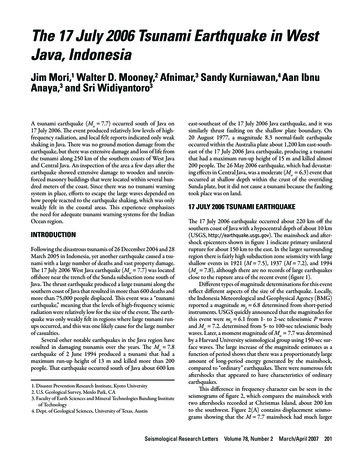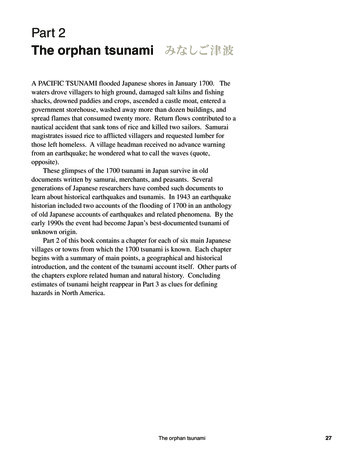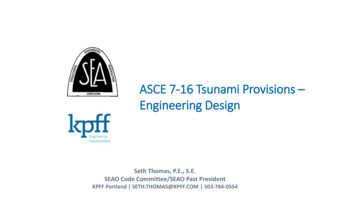
Transcription
The 17 July 2006 Tsunami Earthquake in WestJava, IndonesiaJim Mori, Walter D. Mooney, Afnimar, Sandy Kurniawan, Aan Ibnu Anaya, and Sri WidiyantoroJim Mori,1 Walter D. Mooney,2 Afnimar,3 Sandy Kurniawan,4 Aan IbnuAnaya,3 and Sri Widiyantoro3A tsunami earthquake (Mw 7.7) occurred south of Java on17 July 2006. The event produced relatively low levels of highfrequency radiation, and local felt reports indicated only weakshaking in Java. There was no ground motion damage from theearthquake, but there was extensive damage and loss of life fromthe tsunami along 250 km of the southern coasts of West Javaand Central Java. An inspection of the area a few days after theearthquake showed extensive damage to wooden and unreinforced masonry buildings that were located within several hundred meters of the coast. Since there was no tsunami warningsystem in place, efforts to escape the large waves depended onhow people reacted to the earthquake shaking, which was onlyweakly felt in the coastal areas. This experience emphasizesthe need for adequate tsunami warning systems for the IndianOcean region.INTRODUCTIONFollowing the disastrous tsunamis of 26 December 2004 and 28March 2005 in Indonesia, yet another earthquake caused a tsunami with a large number of deaths and vast property damage.The 17 July 2006 West Java earthquake (Mw 7.7) was locatedoffshore near the trench of the Sunda subduction zone south ofJava. The thrust earthquake produced a large tsunami along thesouthern coast of Java that resulted in more than 600 deaths andmore than 75,000 people displaced. This event was a “tsunamiearthquake,” meaning that the levels of high-frequency seismicradiation were relatively low for the size of the event. The earthquake was only weakly felt in regions where large tsunami runups occurred, and this was one likely cause for the large numberof casualties.Several other notable earthquakes in the Java region haveresulted in damaging tsunamis over the years. The Mw 7.8earthquake of 2 June 1994 produced a tsunami that had amaximum run-up height of 13 m and killed more than 200people. That earthquake occurred south of Java about 600 km1. Disaster Prevention Research Institute, Kyoto University2. U.S. Geological Survey, Menlo Park, CA3. Faculty of Earth Sciences and Mineral Technologies Bandung Instituteof Technology4. Dept. of Geological Sciences, University of Texas, Austineast-southeast of the 17 July 2006 Java earthquake, and it wassimilarly thrust faulting on the shallow plate boundary. On20 August 1977, a magnitude 8.3 normal-fault earthquakeoccurred within the Australia plate about 1,200 km east-southeast of the 17 July 2006 Java earthquake, producing a tsunamithat had a maximum run-up height of 15 m and killed almost200 people. The 26 May 2006 earthquake, which had devastating effects in Central Java, was a moderate (Mw 6.3) event thatoccurred at shallow depth within the crust of the overridingSunda plate, but it did not cause a tsunami because the faultingtook place was on land.17 JULY 2006 TSUNAMI EARTHQUAKEThe 17 July 2006 earthquake occurred about 220 km off thesouthern coast of Java with a hypocentral depth of about 10 km(USGS, http://earthquake.usgs.gov). The mainshock and aftershock epicenters shown in figure 1 indicate primary unilateralrupture for about 150 km to the east. In the larger surroundingregion there is fairly high subduction zone seismicity with largeshallow events in 1921 (M 7.5), 1937 (M 7.2), and 1994(Mw 7.8), although there are no records of large earthquakesclose to the rupture area of the recent event (figure 1).Different types of magnitude determinations for this eventreflect different aspects of the size of the earthquake. Locally,the Indonesia Meteorological and Geophysical Agency (BMG)reported a magnitude mb 6.8 determined from short-periodinstruments. USGS quickly announced that the magnitudes forthis event were mb 6.1 from 1- to 2-sec teleseismic P wavesand Mw 7.2. determined from 5- to 100-sec teleseismic bodywaves. Later, a moment magnitude of Mw 7.7 was determinedby a Harvard University seismological group using 150-sec surface waves. The large increase of the magnitude estimates as afunction of period shows that there was a proportionately largeamount of long-period energy generated by the mainshock,compared to “ordinary” earthquakes. There were numerous feltaftershocks that appeared to have characteristics of ordinaryearthquakes.This difference in frequency character can be seen in theseismograms of figure 2, which compares the mainshock withtwo aftershocks recorded at Christmas Island, about 200 kmto the southwest. Figure 2(A) contains displacement seismograms showing that the M 7.7 mainshock had much largerSeismological Research Letters Volume 78, Number 2 March/April 2007 201
Figure 1. Locations of mainshock (white star) and aftershocks (black circles) from USGS for the 17 July 2006 West Java earthquake.Roman numerals under place names show felt intensities. Figure 2. Waveforms of (A) displacement and (B) velocity high-passed filtered at 1 Hz for the mainshock and two larger aftershocksrecorded at Christmas Island, about 200 km to the southwest.202Seismological Research Letters Volume 78, Number 2March/April 2007
Figure 3. Tsunami run-up heights measured by Kongko et al. (2006) and the Indonesia Ministry of Marine Affairs and Fisheries et al.(2006).low-frequency amplitudes than the M 6 aftershocks. Figure2(B) contains velocity seismograms high-pass filtered at 1 Hz toshow the high-frequency content. The much smaller (in termsof seismic moment) aftershocks have about the same, or slightlylarger, peak amplitudes for the higher frequencies, although theduration is much longer for the mainshock.The coastal areas of West Java and Central Java are about220 km from the source area of the earthquake. For a typicalMw 7.7 earthquake, shaking is usually clearly felt at this distance; however, this was not the case for the 17 July 2006 event.The earthquake was only weakly felt in Pangandaran and othercoastal areas where there were many tsunami casualties. Somepeople in the region did not sense the shaking at all, as shown byan informal questioning of 67 people. Of these, 59 people feltthe earthquake only weakly (MM III–IV) and eight did not feelthe earthquake at all. The 26 May 2006 M 6.3 earthquake inCentral Java, about 200 km to the east, was felt more strongly byalmost everyone in Pangandaran. Other reports (USGS, http://earthquake.usgs.gov) indicate MM III at Cianjur, MM II–IV atBandung, and MM II at Yogyakarta (figure 1). Although shaking from the earthquake was not felt very strongly along thesouthern coast of Java where the tsunami eventually hit, it wasfelt in the cities farther away, where tall buildings swayed andfelt reports indicated MM IV shaking in Jakarta.The smaller magnitudes estimated from short-perioddata and felt reports of low levels of shaking indicate that thisis a so-called “tsunami earthquake,” as discussed by Kanamori(1972), Fukao (1979), and Polet and Kanamori (2000). Theseshallow subduction zone earthquakes have lower levels of highfrequency radiation compared to similar-size ordinary earthquakes. Past examples of this type of event include the 1896Sanriku, 1946 Aleutian, 1963 Kuriles, 1975 Nemuro, 1992Nicaragua, 1994 Java, and 1996 Peru earthquakes (Polet andKanamori 2000).A tsunami magnitude Mt (Abe 1981) can be calculatedfrom amplitudes measured on distant tide gauges using thefollowing equation:Mt log H log D 5.8,where H is the tsunami height and D is the distance. Byusing nine recorded tsunami amplitudes from distances of1,000 to 4,000 km, as reported by the Australian Bureau ofMeteorology and the Pacific Tsunami Warning Center, a relatively large value of Mt 8.1 is determined. This is furtherevidence of the large tsunamigenic strength of this earthquake.THE TSUNAMIA large tsunami occurred over more than 250 km of the southJava coast from Garut prefecture in the west to Yogyakarta prefecture in the east. In the heavily damaged area of Pangandaran,the estimated run-up heights from eyewitness accounts is 4to 6 m. Along the southwest shore of Pangandaran NationalPark, which is a small spit that extends about a kilometer to thesouth, the tsunami was relatively small. From observations ofmarkers consisting of lines of sands and leaves, the tsunami didnot appear very high—about 1 to 2 m. Measurements of runup heights (Indonesia Ministry of Marine Affairs and Fisherieset al. 2006 and Kongko et al. 2006) show variable inundationsranging from 1 to 8 m across the region (figure 3). A tide gaugeat Christmas Island, located about 200 km southwest of the epicenter, recorded a tsunami height of 83 cm.Seismological Research Letters Volume 78, Number 2 March/April 2007 203
Eyewitness accounts consistently mentioned two largewaves with the second wave larger and about 10 to 20 minutesafter the first. Also, Fritz et al. (2006) reported one area nearNusa Kambangan that had an usually high 21-m runup. A tidegauge at Christmas Island, located about 200 km southwest ofthe epicenter, recorded a tsunami height of 83 cm.TSUNAMI DAMAGEThree days after the earthquake, we were in the region of thetsunami to inspect the damage. We visited several sites along thesouth coast of Java from Pangandaran west to Marsawah village.The largest loss of life was in the resort area of Pangandaran,where more than 200 people were killed. Numerous woodenstructure cafes and shops within 20 m of the waterfront were allwashed away by the tsunami. If the tsunami had occurred oneor two days earlier on the weekend, there probably would havebeen many more deaths on the crowded beaches. There wassevere damage to almost all structures within several hundredmeters of the waterfront, where the construction was predominantly one- and two-story buildings of unreinforced clay-brickmasonry. Some of the larger hotels appeared to have betterconstruction and suffered less structural damage. Damage consisted of collapsed walls, walls with large holes (especially wherewindows and doorway once existed), and large piles of debrisconsisting of building material and small boats (figures 4A andB). Damage extended several hundred meters from the shore.At two other villages, Batu Hiu and Batu Karas, located 13 and18 km west of Pangandaran, respectively, there was similar tsunami damage to buildings.The most severe damage we saw was in Marsawah village,Bulakbenda, located about 22 km southwest of Pangandaran.Within about 150 m of the coast, all of the buildings were completely washed away; there were no walls standing and only thefloors and foundations remained (figure 5). The buildings wereone- and two-story residences of clay-brick masonry construction. Further inland, at distances of 300 to 500 m, many of thebuildings were also completely destroyed. Eyewitness accountsreport that the tsunami had heights of 6 to 8 m. It was reportedthat waves broke about 200 to 300 m inland from the shore andcame down vertically on top of the houses in this region.In addition to the direct damage caused by the tsunami,there have been about 75,000 residents displaced either becausetheir houses were destroyed or they are afraid of returning totheir homes, according to the National Disaster ManagementCoordinating Board of Indonesia. Aftershocks and smallerearthquakes in the area continue to send residents scramblingfor higher ground in fear of another tsunami. Health officialsare worried about the spread of disease among the severalthousand displaced people and are giving injections to protectpeople from measles, tetanus, cholera, and other sicknesses. Thebeach resort of Pangandaran, which was hardest hit by the tsunami, was temporarily closed to the public on 20 July 2006 dueto possible looting and the need to clean up debris.204Seismological Research Letters Volume 78, Number 2TSUNAMI WARNINGSBecause the tsunami warning system had not yet been completedfor this region, saving lives from the large waves has depended onthe local knowledge of what to do when a large offshore earthquake occurs. Both the National Oceanic and AtmosphericAdministration (NOAA) Pacific Tsunami Warning Center inHawaii and the Japanese Meteorological Agency issued a tsunami “watch” (not a warning) within 30 minutes. However,the bulletin reported an M 7.2 earthquake, and there wasno effective way for this information to be disseminated to thepublic. There were many people who felt the earthquake andconsequently moved away from the shore, although the low levels of felt shaking meant that most people did not feel a sense ofurgency to move to higher ground. Probably a more dramaticsign that caused people to move away from the beach was theobservation that the water receded significantly from the shore,exposing an additional 5 to 10 m of beach.The low level of shaking from this earthquake points out theimportance of monitoring the low-frequency energy of earthquakes with the tsunami warning systems that are being developed in Indonesia and other regions of the world. Althoughthis type of tsunami earthquake is not common, its occurrencecan cause great loss of life. The initial magnitude estimated forthis earthquake based on peak amplitudes of first-arriving highfrequency seismic data would not have been adequate to issueappropriate tsunami warnings.CURRENT EFFORTS FOR IMPROVING WARNINGSSince the 26 December 2004 tsunami, international partners have been working to strengthen seismic monitoring inIndonesia. While plans are continually evolving, Germany,Japan, and China intend to install 20, 15, and 10 broadbandinstruments respectively by 2007. BMG hopes to have a totalof 106 broadband stations by the end of 2007, with 14 new stations installed by the end of 2006 (figure 6). There are also planssupported by the German government and the U.S. Agency forInternational Development and NOAA to install deep-oceanbuoys off the coast of Indonesia in order to identify tsunamiswhile they are still at sea. Across the region, the Indian OceanTsunami Warning System is providing technical support inareas of hazard detection, warning formulation, and information dissemination. In related efforts, the United NationsEducation, Scientific and Cultural Organization (UNESCO)announced in June 2006 that a temporary warning system wasoperational and that alerts could be relayed to Indian Oceannations from existing tsunami monitoring centers in Hawaiiand Japan. Also, the U.S. Geological Survey (USGS), alongwith the International Tsunami Information Centre have beenproviding basic seismological training to BMG employees. Suchtechnical training programs continue to be a high priority.The level of preparedness varies among other Indian Oceannations. Thailand, which was also hit by the 26 December 2004tsunami, has constructed 62 siren towers along the beaches in sixprovinces, each capable of alerting people as far inland as 2 km.March/April 2007
Figure 4(A). Tsunami damage to unreinforced masonry buildings and debris in Pangandaran. Figure 4(B). Damage to buildings near Pangandaran. Note the damaged roof on the building on the left, which indicates the height ofthe tsunami.Seismological Research Letters Volume 78, Number 2 March/April 2007 205
Figure 5. Severe damage in Marsawah village, where no walls were left standing within about 150 m of the shore. Figure 6. Planned international real-time broadband network for Indonesia. The nine white triangles represent existing broadband stations operated by Indonesia. The other triangles are stations to be installed between 2005 and 2007.206Seismological Research Letters Volume 78, Number 2March/April 2007
The alerts are issued by the National Disaster Warning Center,a government branch created after the devastating effects of the26 December 2004 tsunami. Sri Lanka has coordinated withUNESCO’s regional efforts and developed a system for spreading warnings from the capital by using churches and temples tosound the alarm. Malaysia has an ongoing program to improveits seismic monitoring and tsunami alert system.CONCLUSIONSThe 17 July 2006 earthquake (Mw 7.7) that occurred near thetrench of the Sunda arc was a tsunami earthquake with a relatively low level of high-frequency radiation, as reflected in theshort-period magnitude estimates and the local felt reports.There was no shaking damage from the earthquake and theevent was only slightly felt in coastal areas, but the large tsunami killed more than 600 people and caused extensive property damage. Because there was no tsunami warning system inplace for the southern coast of Java, people escaping the tsunamineeded to respond to weak earthquake shaking and observations of the initial outward flow of the sea. This experienceemphasizes the need for seismic monitoring at low frequenciesas well as the implementation of a robust public warning system.ACKNOWLEGMENTSWe received support from the Kyoto University Centers ofExcellence Program (KAGI21). WDM received support fromthe U.S. Agency for International Development. We thankmembers of the faculty of the Department of Earth Sciencesand Mineral Technologies, Bandung Institute of Technology,for their support.REFERENCESAbe, K. (1981). Physical size of tsunamigenic earthquakes of thenorthwestern Pacific. Physics of the Earth and Planetary Interiors 27,194–205.Fritz, H., J. Goff, C. Harbitz, B. McAdoo, A. Moore, H. Latief, N.Kalligeris, W. Kodjo, B. Uslu, V. Titov, C. Synolakis (2006). Surveyof the July 17, 2006 Central Javan tsunami reveals 21m runupheights. 2006 American Geophysical Union fall meeting (abstract).Fukao, Y. (1979). Tsunami earthquakes and subduction processes neardeep-sea trenches. Journal of Geophysical Research 84, 2,303–2,314.Indonesia Ministry of Marine Affairs and Fisheries, Japan Port and AirportResearch Institute, Japan Society of Civil Engineers (2006). joint%20survey.pdfKanamori, H. (1972). Mechanism of tsunami earthquakes. Physics of theEarth and Planetary Interiors 6, 346–359.Kongko, W., Suranto, Chaeroni, Aprijanto, Zikra, Sujantoko (2006).Rapid survey on tsunami Java 17 July 2006.Polet, J., and H. Kanamori (2000). Shallow subduction zone earthquakesand their tsunamigenic potential. Geophysical Journal International142, 684–702.Disaster Prevention Research InstituteKyoto UniversityGokasho, Uji, Kyoto 611-0011 Japanmori@eqh.dpri.kyoto-u.ac.jp( J.M.)Seismological Research Letters Volume 78, Number 2 March/April 2007 207
The 17 July 2006 West Java earthquake (M w 7.7) was located offshore near the trench of the Sunda subduction zone south of Java. The thrust earthquake produced a large tsunami along the southern coast of Java that resulted in more than 600 deaths and more than 75,000 people displaced. This event was a "tsunami










